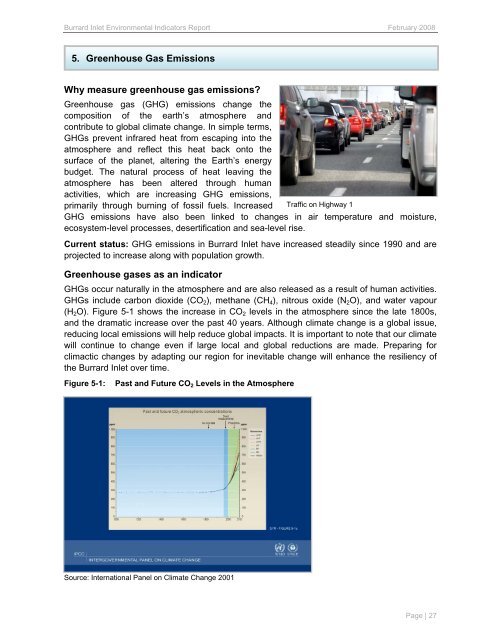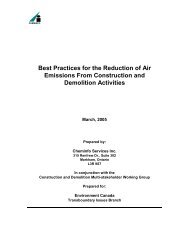Burrard Inlet Environmental Indicators Report - the BIEAP and ...
Burrard Inlet Environmental Indicators Report - the BIEAP and ...
Burrard Inlet Environmental Indicators Report - the BIEAP and ...
You also want an ePaper? Increase the reach of your titles
YUMPU automatically turns print PDFs into web optimized ePapers that Google loves.
<strong>Burrard</strong> <strong>Inlet</strong> <strong>Environmental</strong> <strong>Indicators</strong> <strong>Report</strong> February 2008<br />
• 5. Greenhouse Gas Emissions<br />
Why measure greenhouse gas emissions?<br />
Greenhouse gas (GHG) emissions change <strong>the</strong><br />
composition of <strong>the</strong> earth’s atmosphere <strong>and</strong><br />
contribute to global climate change. In simple terms,<br />
GHGs prevent infrared heat from escaping into <strong>the</strong><br />
atmosphere <strong>and</strong> reflect this heat back onto <strong>the</strong><br />
surface of <strong>the</strong> planet, altering <strong>the</strong> Earth’s energy<br />
budget. The natural process of heat leaving <strong>the</strong><br />
atmosphere has been altered through human<br />
activities, which are increasing GHG emissions,<br />
primarily through burning of fossil fuels. Increased Traffic on Highway 1<br />
GHG emissions have also been linked to changes in air temperature <strong>and</strong> moisture,<br />
ecosystem-level processes, desertification <strong>and</strong> sea-level rise.<br />
Current status: GHG emissions in <strong>Burrard</strong> <strong>Inlet</strong> have increased steadily since 1990 <strong>and</strong> are<br />
projected to increase along with population growth.<br />
Greenhouse gases as an indicator<br />
GHGs occur naturally in <strong>the</strong> atmosphere <strong>and</strong> are also released as a result of human activities.<br />
GHGs include carbon dioxide (CO2), methane (CH4), nitrous oxide (N2O), <strong>and</strong> water vapour<br />
(H2O). Figure 5-1 shows <strong>the</strong> increase in CO2 levels in <strong>the</strong> atmosphere since <strong>the</strong> late 1800s,<br />
<strong>and</strong> <strong>the</strong> dramatic increase over <strong>the</strong> past 40 years. Although climate change is a global issue,<br />
reducing local emissions will help reduce global impacts. It is important to note that our climate<br />
will continue to change even if large local <strong>and</strong> global reductions are made. Preparing for<br />
climactic changes by adapting our region for inevitable change will enhance <strong>the</strong> resiliency of<br />
<strong>the</strong> <strong>Burrard</strong> <strong>Inlet</strong> over time.<br />
Figure 5-1: Past <strong>and</strong> Future CO2 Levels in <strong>the</strong> Atmosphere<br />
Source: International Panel on Climate Change 2001<br />
Page | 27
















